Stuffed Artichokes
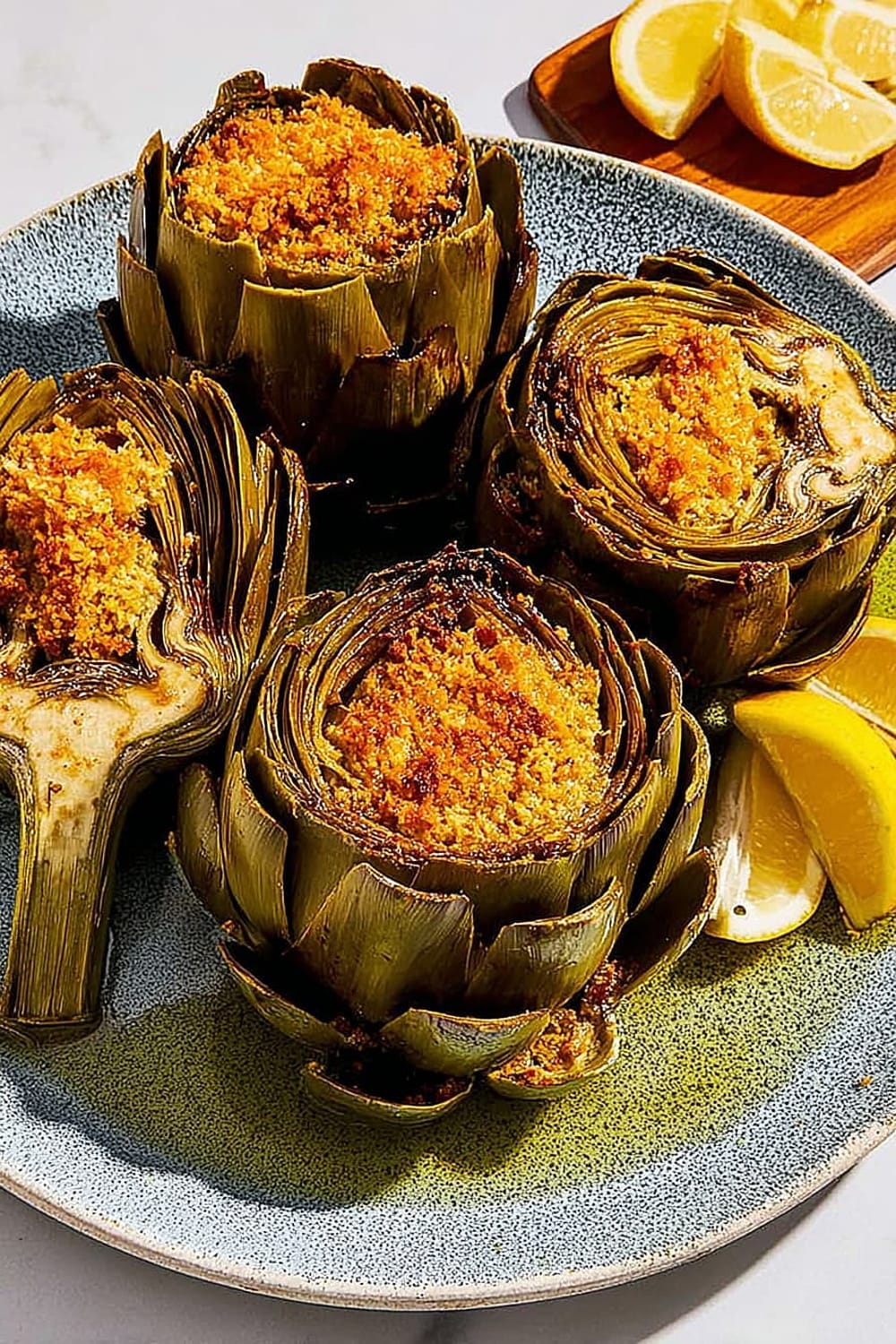
These Italian showstoppers are basically edible flowers that make you look like a culinary genius, even if you’re just following directions and trying not to mess up the breadcrumb ratio.
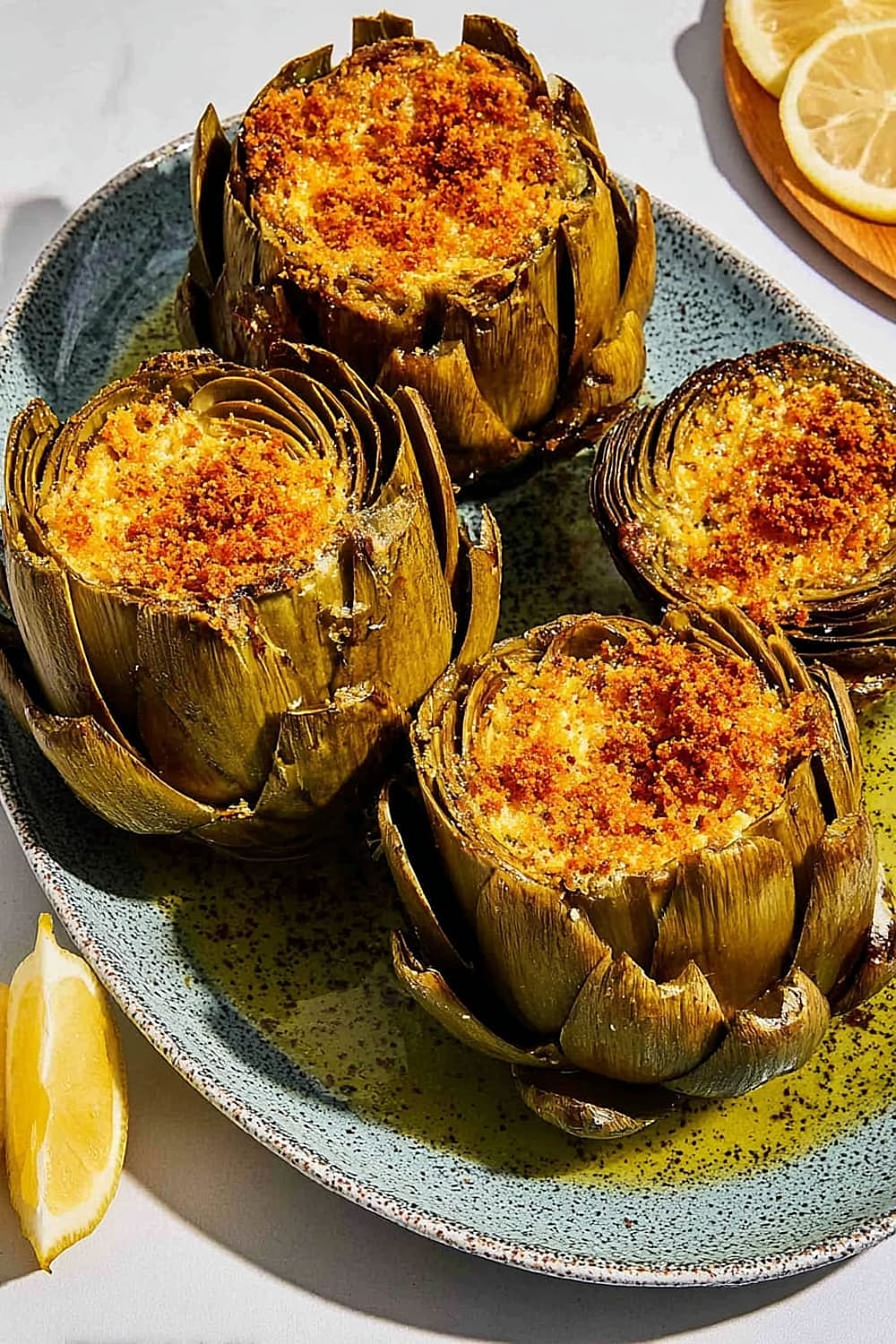
Picture this: tender artichoke leaves practically falling off at your touch, each one loaded with garlicky, cheesy breadcrumbs that somehow taste like sunshine and Italian grandmothers’ kitchens rolled into one bite.
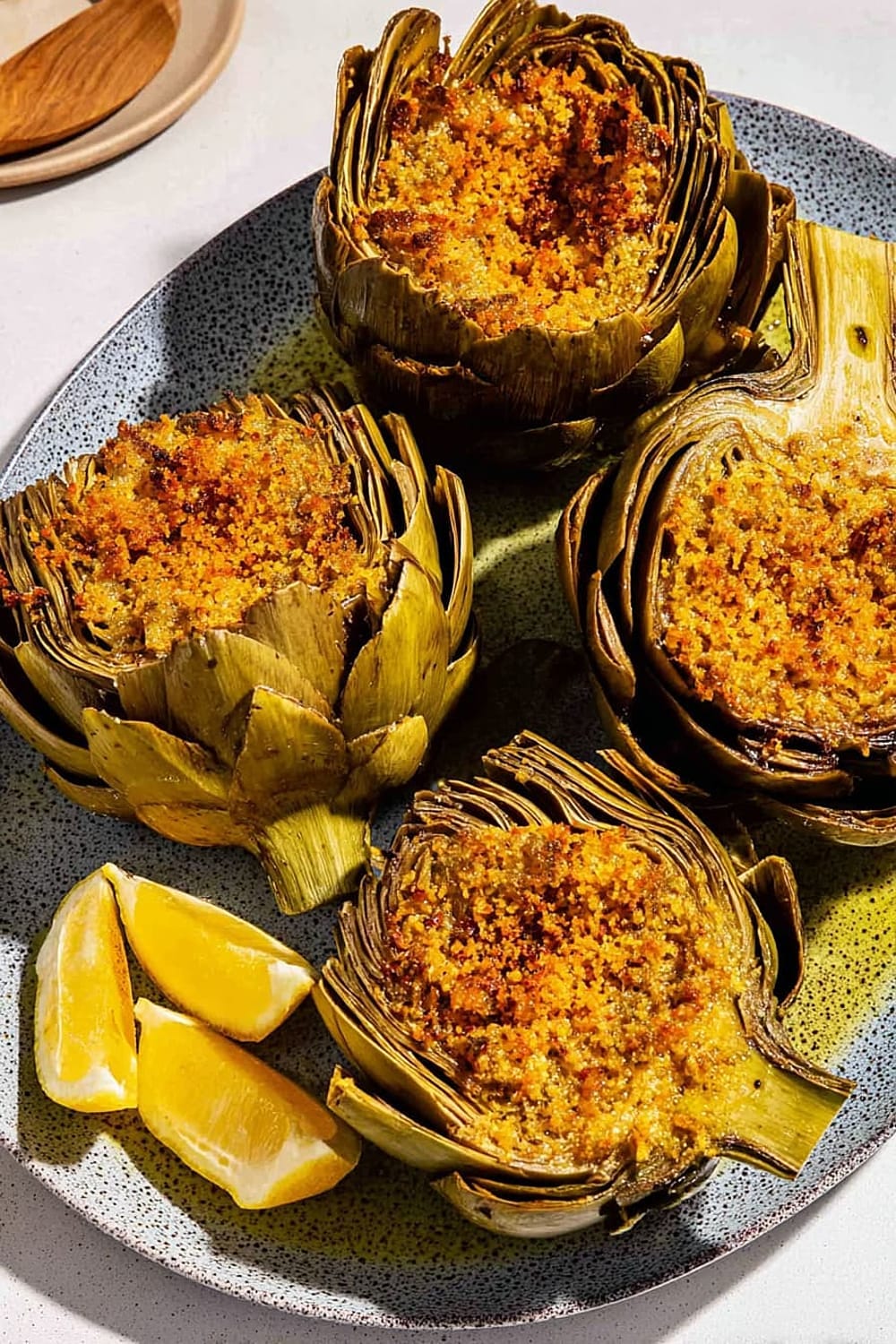
The best part about stuffed artichokes is that they’re simultaneously fancy enough for company and rustic enough for a Tuesday night when you want to feel like you’re dining in a Roman trattoria instead of your regular kitchen.
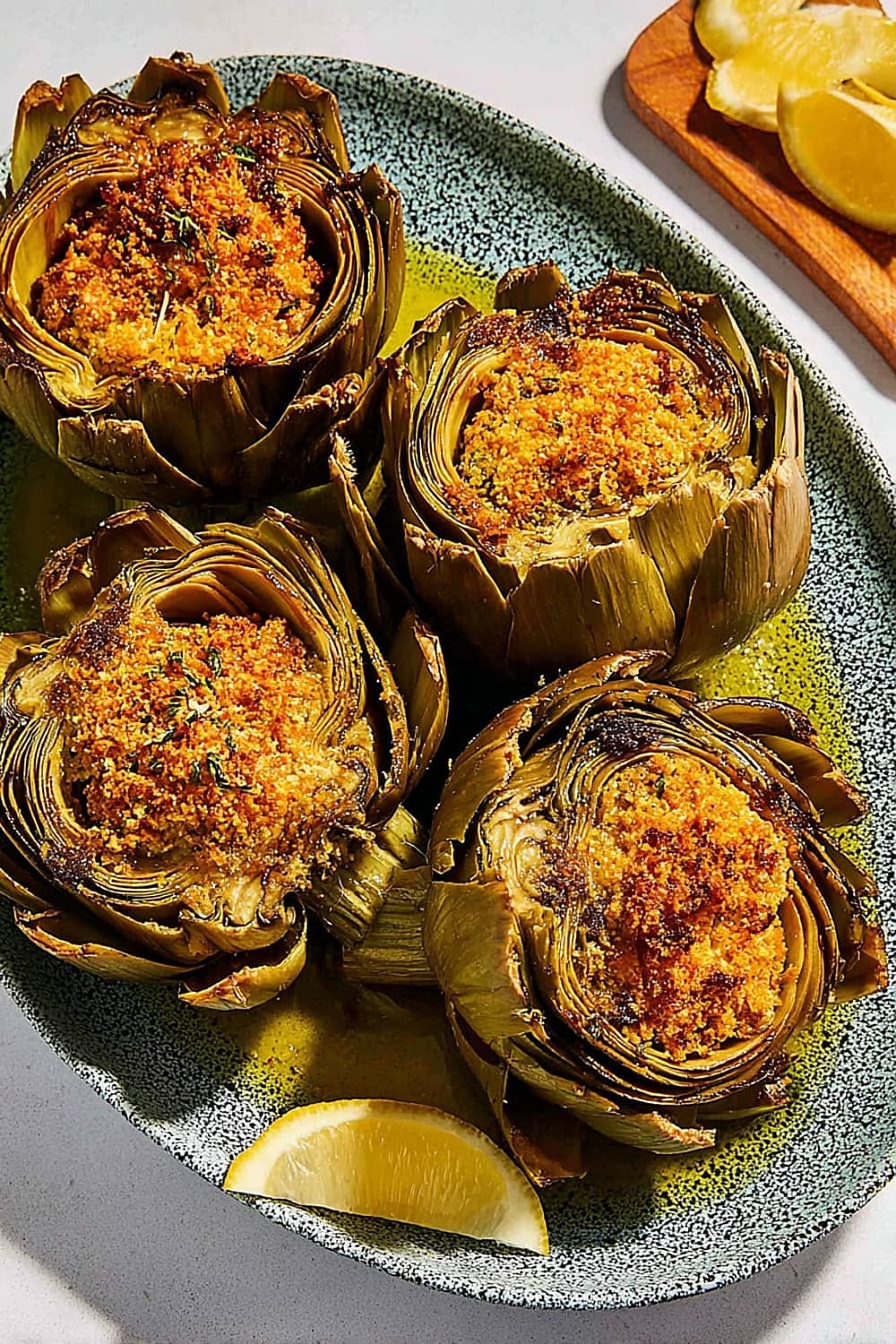
Warning: making these will result in people dramatically sighing with pleasure and asking if you secretly went to culinary school, when really you just stuffed some leaves and let the oven do the heavy lifting.
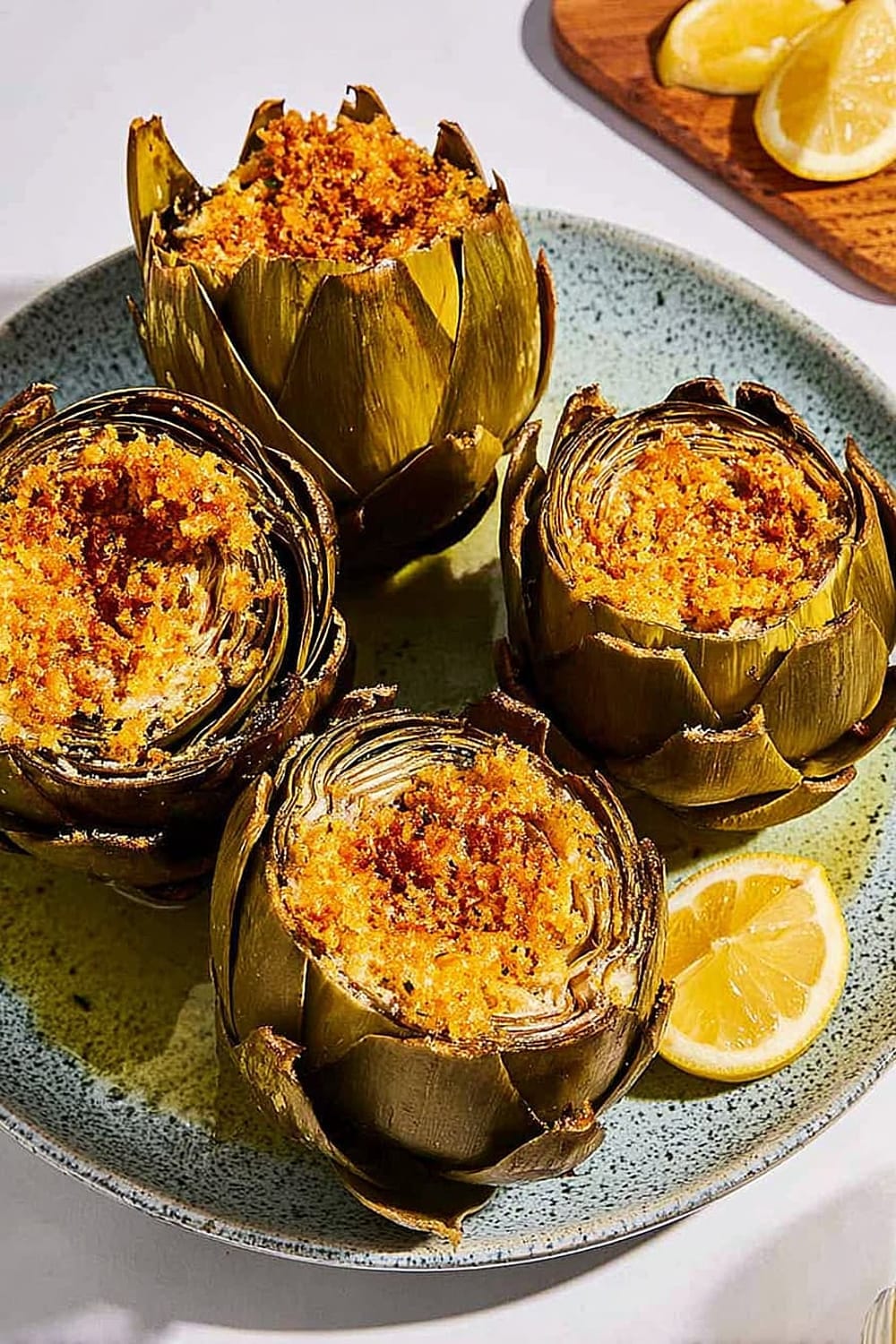
Each artichoke becomes its own little treasure hunt as you work your way through the layers, discovering pockets of savory filling tucked between tender leaves that have been slowly braised to perfection.
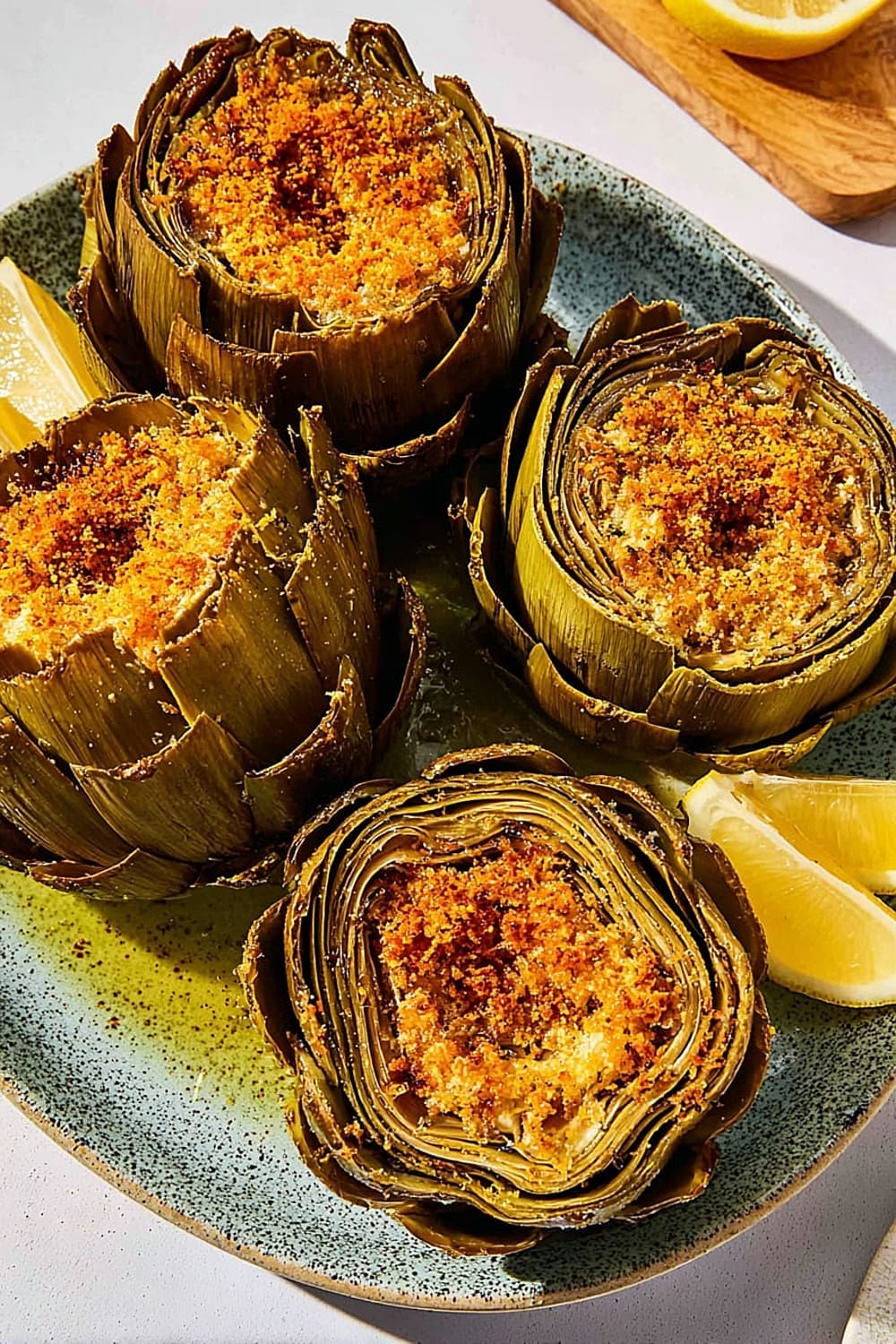
This recipe is proof that sometimes the most impressive dishes are actually the simplest ones – just quality ingredients, a little patience, and the magic that happens when you let time and heat transform something ordinary into something extraordinary.
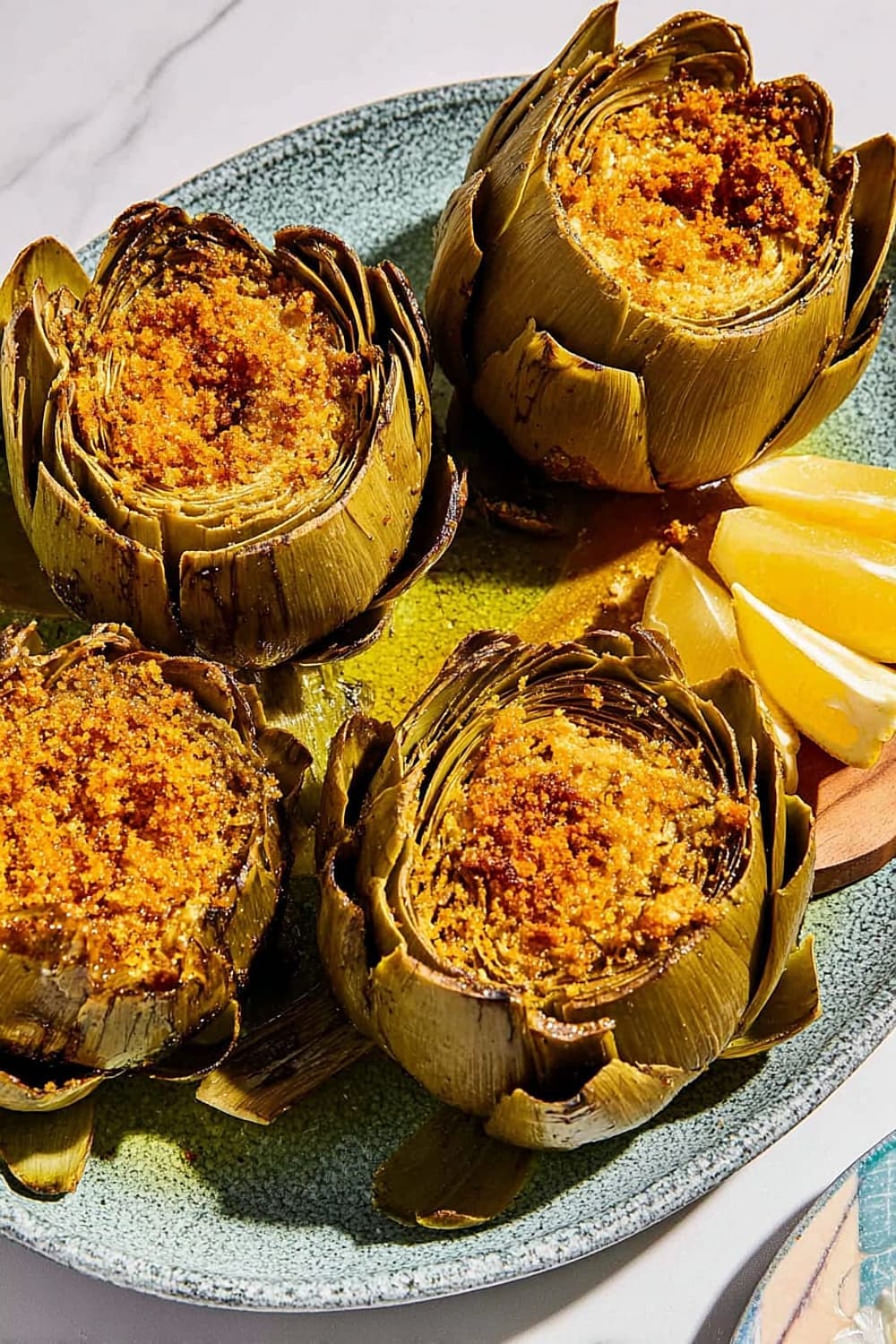
Ingredients
For the Breadcrumb Stuffing
- 1 cup unseasoned dried breadcrumbs
- 3 garlic cloves, pressed or minced
- 3 tablespoons minced flat leaf parsley
- 3 /4 cup freshly grated Parmigiano-Reggiano or Pecorino Romano cheese, or a combination of both
- Kosher salt
- Freshly ground black pepper
- Extra virgin olive oil
For the Artichokes
- 1 small lemon
- 4 globe artichokes
- 1 /2 cup dry white wine
Instructions
Preparation
- 1 Preheat the oven to 375°F (190°C). This moderate temperature ensures the artichokes braise gently without the breadcrumb topping burning during the long cooking process.
- 2 In a medium mixing bowl, combine the breadcrumbs, minced garlic, parsley, and grated cheese. Season generously with salt (about 1/2 teaspoon or to taste) and several grindings of fresh black pepper. The mixture should smell fragrant and well-balanced.
- 3 Drizzle 1 to 2 tablespoons extra virgin olive oil over the breadcrumb mixture and stir thoroughly with a fork. Use just enough oil to moisten the breadcrumbs without making them clump together – they should hold together lightly when pressed but still feel fluffy. Set aside while you prepare the artichokes.
Artichoke Preparation
- 4 Fill a large bowl with cold water and squeeze the juice of the small lemon into it. This acidulated water prevents the artichokes from browning while you work. Clean and trim each artichoke by removing the tough outer leaves and cutting off the top third of the remaining leaves. Trim the stem to about 1 inch long, peeling away the tough outer layer. Immediately submerge each prepared artichoke in the lemon water.
Assembly
- 5 Remove the artichokes from the water and set them on a rimmed baking sheet or large shallow bowl to catch any scattered breadcrumbs. Gently spread the leaves apart and stuff the breadcrumb mixture between the leaves, working from the outside in. Pack the filling generously but don’t force it. Sprinkle any remaining filling over the tops of the artichokes.
- 6 Transfer the stuffed artichokes to a Dutch oven or heavy-bottomed pot with a tight-fitting lid. The pot should be just large enough for the artichokes to fit snugly without crowding. Tuck the trimmed stems around the artichokes. If any filling remains, sprinkle it over the tops.
Braising
- 7 Pour the 1/2 cup dry white wine into the bottom of the pot, being careful not to pour it directly over the artichokes and wash away the filling. Add enough water to reach about one-third of the way up the sides of the artichokes. Season the liquid with another pinch of salt and a few grindings of pepper.
- 8 Drizzle 2 to 3 tablespoons extra virgin olive oil over the tops of the stuffed artichokes. This will help the breadcrumbs brown beautifully during cooking.
- 9 Place the pot on the stovetop over medium-high heat and bring the liquid to a rolling boil. As soon as you see vigorous bubbling, cover the pot tightly and transfer it to the preheated oven.
- 10 Braise for approximately 90 minutes, checking every 30 minutes to ensure there’s still liquid in the bottom of the pot. Add more hot water if needed. The artichokes are perfectly done when you can easily pull an outer leaf away without any resistance – it should slide out effortlessly.
Serving
- 11 Carefully transfer each artichoke and its stem to individual shallow bowls or deep plates. Spoon the flavorful pan juices around each artichoke and drizzle with an additional thread of extra virgin olive oil. Serve immediately while hot, and don’t forget to roll up your sleeves for the delicious, hands-on eating experience ahead.
Recommended Equipment and Kitchen Tools
Recommended Tools (for best results)
- Dutch oven or heavy-bottomed pot with tight-fitting lid – essential for even braising and heat retention during the long cooking process
- Sharp paring knife – makes trimming artichokes much easier and safer than struggling with a dull blade
- Large mixing bowls – one for the acidulated water, another for mixing the breadcrumb stuffing
- Rimmed baking sheet – prevents breadcrumb filling from scattering all over your counter during assembly
Helpful Upgrades
- Kitchen scale – for perfectly consistent breadcrumb measurements if you’re making multiple batches
- Microplane grater – creates the finest, most evenly distributed cheese that integrates beautifully with the breadcrumbs
- Silicone-tipped tongs – gentle enough for handling the delicate stuffed artichokes without damaging the filling
- Instant-read thermometer – while not essential, it helps ensure your braising liquid maintains the right temperature
Nice-to-Have Options
- Artichoke scissors – specialized curved scissors designed specifically for trimming artichoke leaves, though regular kitchen shears work fine
- Small ladle – perfect for spooning the flavorful pan juices over the finished artichokes without making a mess
Recipe Variations and Dietary Modifications
Gluten-Free Adaptation
- Replace regular breadcrumbs with gluten-free panko breadcrumbs using the same 1 cup measurement
- Alternatively, make fresh breadcrumbs from gluten-free bread – you’ll need about 2-3 slices processed in a food processor
- Add an extra tablespoon of grated cheese to help bind the gluten-free crumbs together
- Expect a slightly different texture – gluten-free versions tend to be a bit more crumbly but equally delicious
Vegan Modifications
- Substitute the Parmigiano-Reggiano with nutritional yeast (use 1/2 cup) plus 1 tablespoon of ground cashews for richness
- Add 1 teaspoon of lemon zest to brighten the filling and compensate for the missing cheese tang
- Include 2 tablespoons of toasted pine nuts, finely chopped, for extra richness and texture
- Use vegetable broth instead of wine for the braising liquid
Flavor Variations
- Mediterranean style: Add 2 tablespoons chopped sun-dried tomatoes and 1 tablespoon capers to the breadcrumb mixture
- Herb-forward version: Include fresh thyme, oregano, or basil alongside the parsley
- Protein boost: Mix in 1/4 cup finely chopped prosciutto or pancetta with the breadcrumbs
- Lemon lovers: Add 1 tablespoon lemon zest to the filling for extra citrus brightness
Make-Ahead Options
- Stuff the artichokes up to 4 hours ahead and refrigerate covered until ready to braise
- The braising liquid can be prepared a day in advance and stored in the refrigerator
Nutritional Information and Health Benefits
Key Nutritional Highlights
Each serving provides approximately 280-320 calories, with the majority coming from heart-healthy olive oil and complex carbohydrates from the artichokes themselves. The dish delivers about 12 grams of protein from the cheese and 8 grams of dietary fiber from the artichokes. Each serving contains significant amounts of folate, vitamin K, and vitamin C, plus essential minerals like potassium and magnesium.
Health Benefits of Main Ingredients
Artichokes are nutritional powerhouses, containing cynarin and silymarin – compounds that support liver function and may help lower cholesterol levels. They’re also rich in antioxidants, particularly anthocyanins, which give them anti-inflammatory properties. The high fiber content promotes digestive health and helps regulate blood sugar levels. Extra virgin olive oil provides monounsaturated fats that support heart health, while the garlic and parsley contribute additional antioxidants and anti-inflammatory compounds. Parmigiano-Reggiano adds calcium and high-quality protein, plus beneficial probiotics if it’s properly aged.
Dietary Considerations
This recipe is naturally vegetarian and contains gluten (from breadcrumbs) and dairy (from cheese). It’s relatively low in sodium when made as directed, making it suitable for those watching their salt intake. The high fiber content makes it quite filling, so one artichoke per person is typically sufficient as a main course when paired with a light salad or crusty bread.
Smart Swaps and Ingredient Substitutions
Common Substitutions:
- Parmigiano-Reggiano → Pecorino Romano or aged Asiago (use same amount, but expect a sharper, saltier flavor)
- Fresh breadcrumbs → Panko breadcrumbs (use 3/4 cup panko instead of 1 cup regular breadcrumbs for lighter texture)
- Flat-leaf parsley → Fresh basil or oregano (use 2 tablespoons instead of 3, as these herbs are more potent)
- Dry white wine → Vegetable broth or chicken stock (maintains moisture without alcohol)
Budget-Friendly Swaps:
- Parmigiano-Reggiano → Sharp cheddar or Romano cheese from the deli counter (about half the cost)
- Extra virgin olive oil → Regular olive oil for cooking, reserve the good stuff for final drizzling
- Fresh artichokes → Frozen artichoke hearts when fresh are expensive (thaw completely and pat dry first)
Pantry Emergency Substitutions:
- Fresh garlic → Garlic powder (use 1 teaspoon powder instead of 3 fresh cloves)
- Fresh parsley → Dried parsley (use 1 tablespoon dried) or fresh chives (same amount)
- Lemon juice → White wine vinegar or apple cider vinegar for the acidulated water
Pro Tips for Substitutions:
- When using pre-grated cheese, reduce the amount by about 2 tablespoons since it’s more densely packed
- Store leftover fresh breadcrumbs in the freezer for up to 3 months – no need to thaw before using
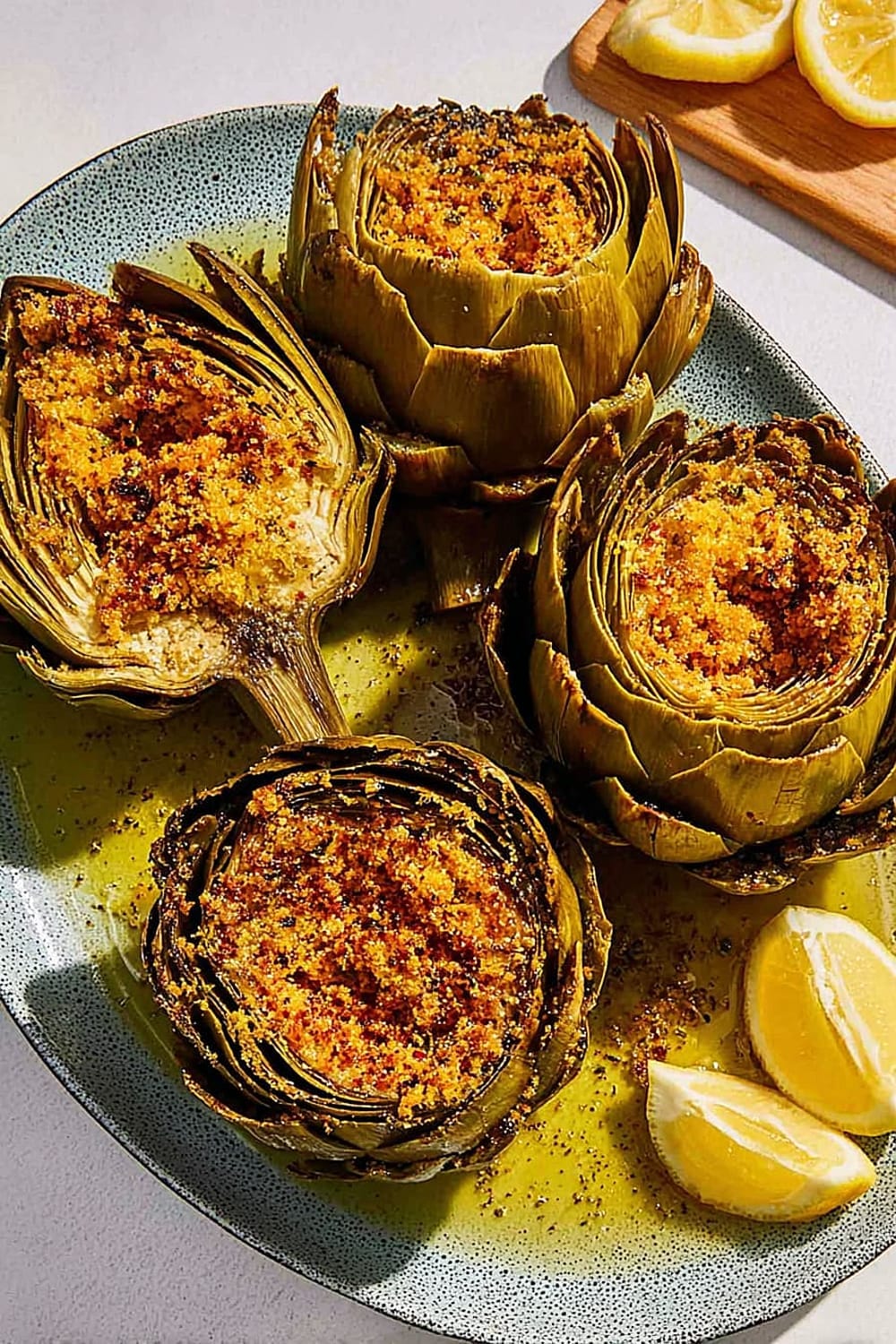
Make It Diabetes-Friendly
Carb Reduction Strategies:
- Replace breadcrumbs → Use crushed pork rinds or almond flour (reduce to 3/4 cup) for a low-carb stuffing that’s equally satisfying
- Portion control → Serve half an artichoke as a side dish instead of a whole one as a main course
- Add protein → Include 2 tablespoons of chopped cooked chicken or turkey in the stuffing to increase satiety
Enhanced Fiber Content:
- Double the herbs → Extra parsley and fresh herbs add flavor without carbs while boosting antioxidants
- Add vegetables → Mix 2 tablespoons of finely diced bell peppers or zucchini into the stuffing for extra nutrients and fiber
Blood Sugar Management Tips:
- Pair strategically → Serve alongside a mixed green salad with olive oil dressing to slow carb absorption
- Timing matters → The high fiber content in artichokes naturally helps stabilize blood sugar when eaten as part of a balanced meal
- Portion awareness → One whole stuffed artichoke contains approximately 25-30 grams of total carbohydrates
Total Carb Reduction: Using almond flour instead of breadcrumbs reduces total carbs by approximately 15 grams per serving while maintaining the satisfying texture and flavor profile.
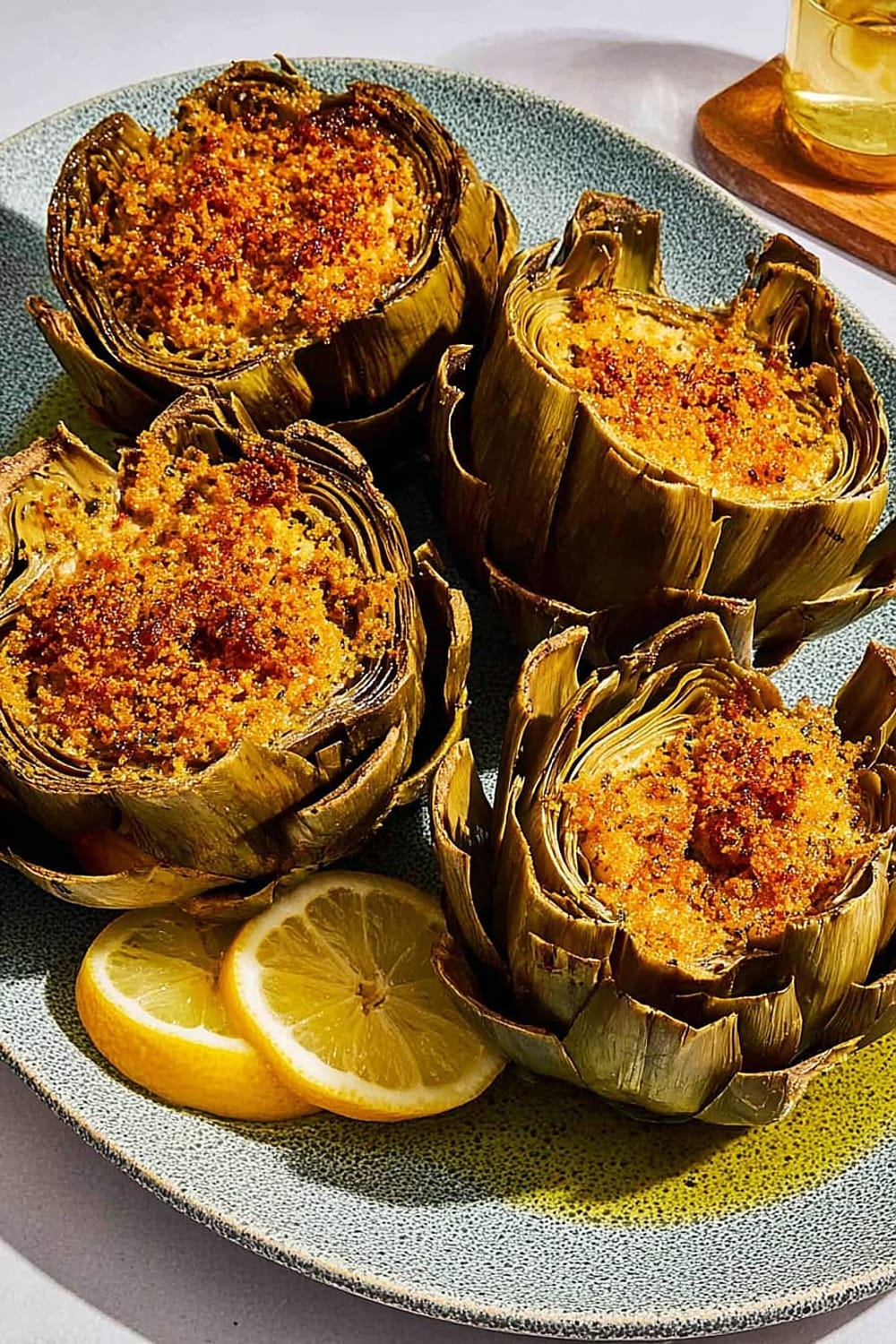
Perfect Pairing Suggestions
Beverage Pairings
A crisp Pinot Grigio or Sauvignon Blanc complements the herbaceous, garlicky flavors without overwhelming the delicate artichoke taste. For red wine lovers, try a light Chianti Classico or Barbera d’Alba. Non-alcoholic options include sparkling water with lemon or unsweetened iced tea with fresh mint. The earthy, savory nature of this dish also pairs beautifully with Italian sodas like Aranciata or Limonata.
Side Dish Recommendations
Serve alongside crusty Italian bread for sopping up the flavorful braising juices, or offer focaccia with rosemary and sea salt. A simple arugula salad with lemon vinaigrette provides a peppery contrast to the rich, cheesy filling. Roasted cherry tomatoes with basil make an excellent warm side that echoes the Mediterranean flavors. For a heartier meal, add creamy polenta or risotto to turn this into a more substantial dinner.
Complete Meal Ideas
Start with antipasto featuring olives, cured meats, and fresh mozzarella. Follow the stuffed artichokes with grilled fish or chicken piccata for a full Italian feast. End with panna cotta or fresh berries with a drizzle of balsamic reduction. For casual entertaining, serve family-style with pasta e fagioli and plenty of good bread.
Occasion Suggestions
These stuffed artichokes shine at spring dinner parties when artichokes are at their peak, Mother’s Day brunches, or romantic dinners where the hands-on eating creates an intimate, playful atmosphere. They’re also perfect for Italian-themed gatherings or any time you want to slow down and savor a meal that encourages conversation and lingering at the table.
Pro Tips and Troubleshooting
Professional Techniques
Choose artichokes that feel heavy for their size with tightly closed leaves – these indicators mean they’re fresh and will be tender after braising. When trimming, rub all cut surfaces immediately with lemon to prevent browning, and don’t skip the acidulated water bath. The key to perfect stuffing distribution is gently spreading the leaves while the artichoke is upside down, then turning it right-side up to pack in the filling. Pro secret: Add a splash of the braising liquid to any leftover filling to create a paste that seals the top beautifully.
Common Mistakes and Solutions
Tough artichokes usually mean they weren’t cooked long enough – they can take up to 2 hours depending on size, so be patient. Soggy breadcrumbs result from too much oil in the mixture or pouring liquid directly over the artichokes. Burnt tops happen when the oven temperature is too high; stick to 375°F and cover with foil if browning too quickly. Dry artichokes occur when there’s insufficient liquid in the pot – check every 30 minutes and add hot water as needed.
Storage and Make-Ahead
Leftover stuffed artichokes keep refrigerated for 3 days and actually taste better the next day as flavors meld. Reheat gently in a 300°F oven covered with foil, adding a splash of broth to prevent drying. You can prep the filling 24 hours ahead and stuff the artichokes 4 hours before cooking. For entertaining, start them 2.5 hours before serving time to account for prep and cooking.
Scaling and Presentation
This recipe doubles easily – just use a larger pot or two separate Dutch ovens. For elegant presentation, serve in shallow pasta bowls with small spoons for the pan juices. Provide finger bowls with lemon water and plenty of napkins since eating stuffed artichokes is delightfully messy. Discard pile bowls for the spent leaves make the experience more enjoyable for guests.
The magic of stuffed artichokes lies not just in their incredible flavor, but in the ritual of eating them – the slow, meditative process of pulling away each leaf, savoring the filling, and working your way to the tender heart. It’s food that forces you to slow down, connect with your meal, and appreciate the simple pleasure of something made with care and time. Whether you’re cooking for family or friends, these Italian classics transform any dinner into a memorable experience that celebrates both the ingredients and the joy of sharing good food together.